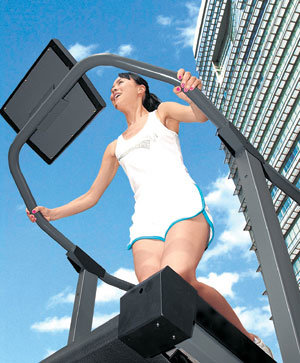An Unbalanced Workout Can Be Hazardous to Your Health
An Unbalanced Workout Can Be Hazardous to Your Health
Posted October. 10, 2005 03:03,

Mr. Kim is a thirty-something office worker who has diligently worked out at a gym for the past two years. Everyone could see that he was a muscular man. Feeling the envy of the people around him, Kim was very pleased with his work out program.
However, after going through a regular check up, he doubted the results. It said that his risks of developing adult diseases had slightly increased. Furthermore his heart and lung endurance had also greatly been reduced.
The problem was his unbalanced workouts. With the current fad on looking fit, similar cases to Kims are not difficult to find. They only start asking what the problem is after receiving the results of their check ups.
Balance Your Work Out According to Your Condition: Cardiovascular Workout First, Muscle Workout Later
Workouts can be divided into cardiovascular, muscle strength and flexibility workouts. Focusing on only one will significantly decrease the results of working out. For example, by only doing cardiovascular workouts, one might get rid of obesity, but one will definitely feel languid.
Experts advise obese people to keep their cardiovascular, muscle, and flexibility workout ratio 5:3:2. For thin people it should be 3:5:2 and 4:4:2 for average people.
The order of the workout should also be maintained. Always warm up, work out and cool down.
Flexibility workouts such as free gymnastics or stretching is suggested for warm ups. It is also all right to walk or ride a bicycle, at low intensity, for a short time. The time should be set between five to 10 minutes, until one starts to sweat a bit. The muscle temperature rises and the heartbeat and respiration increases, making the body condition goof for a workout.
The main workout is composed of cardiovascular and muscular exercise. It is usually suggested to start cardiovascular exercises first and then do the muscular workout. An ideal time for work out is between 20 to 60 minutes. A muscular workout should start with the large muscle groups and then move toward smaller muscles. It is good to go from hips and thighs to chest, back, legs and ankles, shoulders, abdomen and wrists.
Cooling down will eliminate waste material accumulated in the muscles during the workout and increase flexibility. Five to 10 minutes of gymnastics or stretching is appropriate.
Intensity of Workout Should be 60 to 70 Percent for Weight Loss, and 50~60 Percent for Beginners
The higher the intensity of the workout, the greater amount of energy is used and more body fat burned. However, high intensity workouts are not appropriate for everybody. One should decide the intensity of the workout depending on ones goal.
If it is a cardiovascular workout, subtract your age from 220 and multiply it by your workout intensity index. Maintain your heart rate during the workout at that number.
If losing weight is your goal, keep your workout intensity at 60 to 70 percent. In order to improve heart and lung functions, keep it at around 70 to 80 percent and 80 to 90 percent, if you want to maximize your heart and lung functions. Beginners should start at a low intensity level between 50 to 60 percent.
Lets take the example of a 30-year man who wants to lose weight. Using the numbers in the equation (220-30)×0.6~0.7, his appropriate heart-rate is between 114 to 133. If his heart-rate in within this range, he is doing the right exercise.
Muscular workouts use something called an RM (Repetition Maximum), which is the maximum number of repetitions done in perfect form. So 10 RMs means that one cannot lift properly after 10 repetitions.
Five to eight RMs are advised when building muscle mass, 13 to 15 RMs when toning muscles, and 15 to 20 RMs when strengthening muscle endurance. Do three sets, but be sure to take 30 to 90 second breaks during the sets. In general, it is suggested for women to do three sets of exercises at 15 to 20 RMs. It is fine for male and female beginners to do only one set.
Sang-Hoon Kim corekim@donga.com







